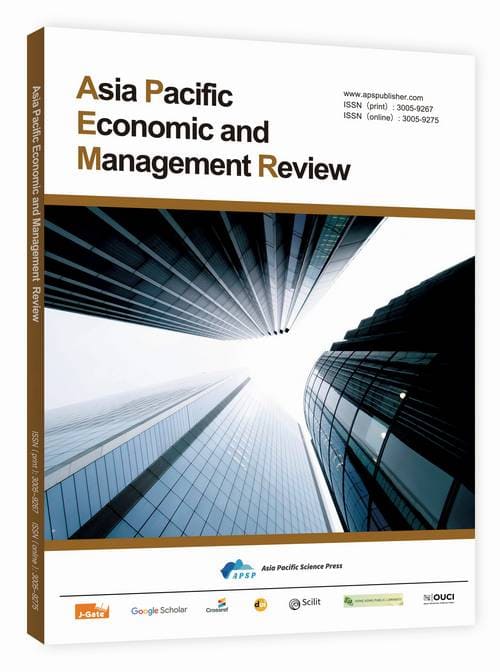A Study on the Spatio-Temporal Characteristics and Spatial Differentiation of the Development Efficiency of China's Digital Cultural Industry
DOI:
https://doi.org/10.62177/apemr.v2i6.765Keywords:
Digital Cultural Industry, Development Efficiency, Spatiotemporal Characteristics, Spatial DifferentiationAbstract
Under the national digital cultural strategy, it is crucial to systematically evaluate and continuously track the development efficiency of China's digital cultural industry. This paper constructs a global super-efficiency EBM model that considers non-expected outputs, empirically measures the development efficiency of China's digital cultural sector from 2011 to 2023, and uses the Moran index and Dagum Gini coefficient methods to comprehensively and deeply reveal the temporal and spatial characteristics and spatial differentiation of China's digital cultural industry development efficiency. The study finds that: (1) The overall efficiency of China's digital cultural industry is relatively low, with an average efficiency of 0.35, exhibiting a typical “V”-shaped distribution across different periods, and the eastern region significantly outperforms other areas. (2) The global Moran index shows a fluctuating downward trend overall, with a “Λ”-shaped distribution across different periods, and the local Moran index reveals that its spatial distribution is primarily concentrated in “H-H” and “L-L” clusters. (3) The overall disparities exhibit a fluctuating upward trend, with inter-regional disparities being the dominant factor, accounting for an average contribution rate of 38.50%. This study aims to promote the high-quality development of China's digital cultural industry by providing valuable references for future policy-making and decision-making.
Downloads
References
Jie, X. F., & Zhang, S. N. (2025). The evolutionary logic and innovative pathways of China's digital cultural industry policy from the perspective of policy tools. Nanjing Social Sciences, 447(1), 135–146. https://doi.org/10.15937/j.cnki.issn1001-8263.2025.01.014
iiMedia Industry Upgrade Research Center. (n.d.). 2024-2025 China digital cultural industry development status and trends analysis report. https://www.iimedia.cn/c400/104005.html
Huang, X., & Chen, M. H. (2025). Application of fuzzy logic inference engine in digital culture industry. International Journal of High Speed Electronics and Systems, 30(2), 150–160. https://doi.org/10.1142/S0129156425500079
Cao, R. Z., Zhao, J., Cao, Y. R., & Zhang, D. Y. (2025). Research on the coexistence model and ecosystem evolution of the digital cultural industry in 29 provinces of China. Fudan Journal (Natural Science Edition), 64(2), 229–242. https://doi.org/10.15943/j.cnki.fdxb-jns.20250403.002
Guo, H. X., & Zeng, G. (2024). An empirical study on the spatial effect of cultural industry innovation efficiency. Polish Journal of Environmental Studies, 30(5), 120–135. https://doi.org/10.15244/pjoes/178213
Wan, S. Y., Wei, M. S., & Amar, N. (2025). Green development efficiency in cultural industries: The role of digitalization in China’s provincial context. Polish Journal of Environmental Studies, 34(2), 1333–1345. https://doi.org/10.15244/pjoes/181234
Li, J. B., Zhang, R., & Yin, Y. (2021). The influence and countermeasures of the application of blockchain on the investment efficiency of cultural industry: DEA analysis of listed companies based on blockchain concept. E3S Web of Conferences, 233, 02027. https://doi.org/10.1051/e3sconf/202123302027
Yao, X. L., & Lu, H. (2024). Evaluating the development level of cultural tourism industry in Hunan Province using dynamic network DEA-Malmquist model. Journal of Computational Methods in Sciences and Engineering, 24(6), 4256–4268. https://doi.org/10.3233/JCM-230123
Wu, P. (2024). The practical path of digital technology enabling the high-quality development of culture industry in Jiangxi Province. Trends in Social Sciences and Humanities Research, 2(12), 394–402. https://doi.org/10.61784/TSSHR3119
Li, Y. P. (2022). Research on performance measurement and promotion countermeasures of digital culture industry in Zhejiang Province. Financial Engineering and Risk Management, 5(5), 171–179. https://doi.org/10.23977/FERM.2022.050510
Shi, H. M., Qiao, Y. J., & Hong, Y. L. J. (2017). The study on the technical efficiency of Chinese cultural industry based on Three-stage DEA model. Journal of North-east Asian Cultures, 1(52), 41–49. https://doi.org/10.17949/jneac.1.52.201709.003
Li, M. X., Sun, H. Z., Agyeman, F. O., Su, J. L., & Hu, W. J. (2021). Efficiency measurement and heterogeneity analysis of Chinese cultural and creative industries: Based on three-stage data envelopment analysis modified by Stochastic Frontier. Frontiers in Psychology, 12(6), 178–189. https://doi.org/10.3389/FPSYG.2021.823499
Jesús, T. P., & Knox, L. C. A. (2005). A global Malmquist productivity index. Economics Letters, 88(2), 266–271. https://doi.org/10.1016/j.econlet.2005.02.013
Tone, K. (2002). A slacks-based measure of super-efficiency in data envelopment analysis. European Journal of Operational Research, 143(1), 32–41. https://doi.org/10.1016/S0377-2217(01)00324-1
Zheng, J., Liu, X., & Bigestr, A. (1998). Ownership structure and determinants of technical efficiency: An application of data envelopment analysis to Chinese enterprises (1986-1990). Journal of Comparative Economics, 26(3), 465–484. https://doi.org/10.1006/jcec.1998.1540
Ma, Y. Y., Xue, D. Q., Song, Y. Y., Gong, Y., & Pang, X. F. (2023). Spatial aggregation of major industries in China's cultural industry and its spillover effects. Journal of Shanxi Normal University (Natural Science Edition), 51(2), 70–78. https://doi.org/10.15983/j.cnki.jsnu.2023120
Dagum, C. (1997). A new approach to the decomposition of the Gini income inequality ratio. Empirical Economics, 22(4), 515–530. https://doi.org/10.1007/BF01205777
Zhang, H. F., Yang, F. T., & Li, X. T. (2022). The spatial layout, dynamic evolution, and formation mechanism of China's cultural industry development. Reform, 34(11), 106–118. https://doi.org/10.3969/j.issn.1003-7543.2022.11.010
Li, Y. P. (2022). Research on performance measurement and promotion countermeasures of digital culture industry in Zhejiang Province. Financial Engineering and Risk Management, 5(5), 171–179. https://doi.org/10.23977/FERM.2022.050510
Wu, H. C., & Lanita, L. (2024). Evaluation of business efficiency of cultural industry companies: Analysis based on SBM model. Sustainable Development, 14(1), 7–14. https://doi.org/10.1002/sd.2900
Zhang, J. Q. (2024). Measurement of innovation efficiency in China's provincial digital cultural industry and analysis of influencing factors. Statistics and Decision Making, 40(4), 102–108. https://doi.org/10.13546/j.cnki.tjyjc.2024.04.019
Zhang, L. B., Li, S. Y., & Wang, J. H. (2023). Spatial network structure and influence mechanisms of green development efficiency in China's cultural industry. Acta Geographica Sinica, 78(5), 1264–1279. https://doi.org/10.11821/dlxb202305010
Kong, L., & Jin, Y. (2023). Digital cultural industries in transition: Policy reconfiguration and market restructuring in China. Asian Studies Review, 47(2), 315–333. https://doi.org/10.1080/10357823.2022.2159368
Keane, M., & Chen, Y. (2024). Platformed creativity: Transnational collaboration in East Asia’s digital cultural economy. Asian Studies Review, 48(1), 89–107. https://doi.org/10.1080/10357823.2023.2290121
Chen, Y., & Wong, T. (2023). Total factor productivity growth in East Asia’s digital cultural sectors: A Malmquist index analysis. Asian Studies Review, 47(4), 612–630. https://doi.org/10.1080/10357823.2023.1987754
Downloads
How to Cite
Issue
Section
License
Copyright (c) 2025 Denggui You

This work is licensed under a Creative Commons Attribution-NonCommercial 4.0 International License.
DATE
Accepted: 2025-10-22
Published: 2025-11-01
















